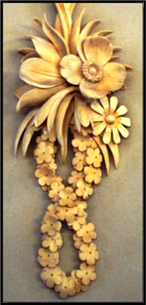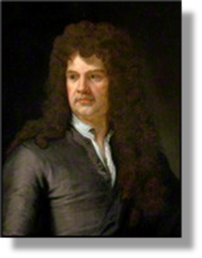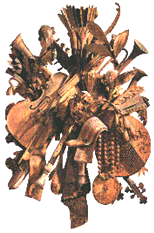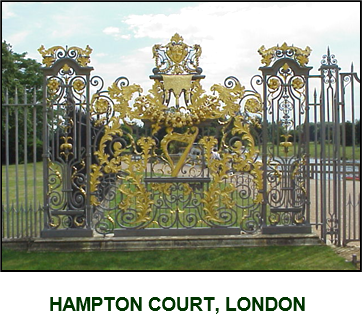


xxxxxThe Englishman Grinling Gibbons was one of the greatest wood carvers of his day. In 1667 he was befriended by the diarist John Evelyn, and he introduced him to the architect Christopher Wren. As early as 1671 he was commissioned by Charles II to decorate the royal apartments at Windsor Castle. He later worked for William and Mary at Hampton Court and Kensington Palace, and became master carver to the Crown in 1693. Some of his finest work -
GRINLING GIBBONS 1648 -
Acknowledgements
Gibbons: detail, portrait after the German/British artist Sir Godfrey Kneller (1646-

 xxxxxGrinling Gibbons, one of the greatest wood carvers of his day, was born and educated in the Netherlands, where his English father had earlier gone to live. He came to England in about 1667 and settled at Deptford in south-
xxxxxGrinling Gibbons, one of the greatest wood carvers of his day, was born and educated in the Netherlands, where his English father had earlier gone to live. He came to England in about 1667 and settled at Deptford in south-
xxxxxOver the years, he produced exquisitely carved wall panels, borders, chimney pieces and screens for a large number of country houses, including Blenheim, Chatsworth and Petworth - his work in St. Paul's Cathedral, completed in 1697. Here, working in close collaboration with Wren, he was responsible for the intricate carving of the choir stalls and the bishop's throne, together with much of the exterior stone ornamentation beneath the lower windows. In addition, he provided decoration for seven of Wren's city churches. A fine example of his skill can be seen in St. James's Church, Westminster. Here his work includes a wooden organ case and reredos, and a marble font designed by Wren
his work in St. Paul's Cathedral, completed in 1697. Here, working in close collaboration with Wren, he was responsible for the intricate carving of the choir stalls and the bishop's throne, together with much of the exterior stone ornamentation beneath the lower windows. In addition, he provided decoration for seven of Wren's city churches. A fine example of his skill can be seen in St. James's Church, Westminster. Here his work includes a wooden organ case and reredos, and a marble font designed by Wren
xxxxxHis still-
Including:
Jean Tijou

 xxxxxGibbons was among the finest of the craftsmen employed by Wren in his rebuilding of St. Paul's Cathedral. Among others who assisted him were the English architect Nicholas Hawksmoor and the French ironworker Jean Tijou. A Huguenot refugee, Tijou came to England in 1689 and was responsible for the iron gates of the choir. He also gained the patronage of the king, his major work for the Crown being the making of a large number of ornate gates and screens for Hampton Court Palace. These and other works doubtless played a part in bringing about a revival of ironwork in England during the 18th century, particularly in London and the university towns of Oxford and Cambridge.
xxxxxGibbons was among the finest of the craftsmen employed by Wren in his rebuilding of St. Paul's Cathedral. Among others who assisted him were the English architect Nicholas Hawksmoor and the French ironworker Jean Tijou. A Huguenot refugee, Tijou came to England in 1689 and was responsible for the iron gates of the choir. He also gained the patronage of the king, his major work for the Crown being the making of a large number of ornate gates and screens for Hampton Court Palace. These and other works doubtless played a part in bringing about a revival of ironwork in England during the 18th century, particularly in London and the university towns of Oxford and Cambridge.
W3-



